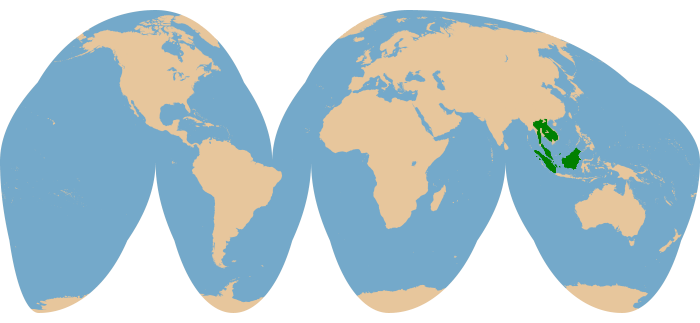Kingdom: |
Animalia Chordata Mammalia Artiodactyla Ruminantia Tragulidae Tragulus |
Common name:
Scientific name:
Other names: |
Lesser Malayan chevrotain
Tragulus kanchil
Lesser oriental chevrotain, lesser mousedeer, kanchil, chevrotain kanchil, petit tragul malais |
Physical Characteristics
- Head and body length:
37-56 cm
- Shoulder height: 25-30 cm
- Tail length: 6-9 cm
- Adult weight: 1.3-2.4 kg
- Shoulder height: 25-30 cm
The smallest ungulate, with a slender build, arched back, and pencil-thin legs. Females tend to be slightly larger than males. The general color is reddish-brown; populations across the species' range vary in the degree of redness and relative brightness. On several smaller islands, there is a trend towards melanism (blackness), particularly on the head, neck, and back. However, these color variations are less striking than in the greater Malayan chevrotain (Tragulus napu). The underparts are white. A dark streak is present on the nape of the neck, although this is less evident in the northern parts of the species' distribution. The underside of the jaw is white; this area connects directly with three white stripes on the throat such that there is a continuous smooth edge from the chin to the lateral stripes. Facial markings are generally lacking. There are no horns or antlers, but males develop enlarged upper canine teeth that protrude from the mouth.
- Similar species
- Very similar to the Javan chevrotain (Tragulus javanicus) in size, coloration, and markings. Range is the most definitive identifier; some Javan chevrotain populations also have distinctive gray necks.
- The differentiation between the lesser chevrotain and northern chevrotain (Tragulus williamsoni) has not been well-studied. Northern chevrotains are significantly larger in size and they do not appear to overlap in range.
- The sympatric greater Malayan chevrotain (Tragulus napu) can be challenging to differentiate in the field. Size is generally unreliable (particularly if dealing with immature animals). Greater chevrotains have more distinctive facial markings and the long white throat stripes do not flow smoothly into the white underside of the jaw.
Reproduction and Development
- Gestation period: 132-145 days reported.
- Litter size: One.
- Weaning: Unknown, but a nursing 21-day-old fawn transitioned easily to solid food upon the death of its mother.
- Sexual maturity: As early as 125 days (females) and 166 days (males).
Lesser chevrotains breed throughout the year and are one of the fastest-reproducing ungulates, with a short gestation (4.5 months) and the ability for females to become pregnant again within two hours of giving birth. The estrous cycle in roughly 14 days in length. Infants weigh 120-190 g at birth and are able to stand within 30 minutes of being born. However, they generally "lie up" in dense brush and are visited by their mothers for nursing, typically twice per day. The milk is very high in fat (26.8%) and the young grow quickly; adult size is reached by 5 months of age.
Ecology and Behavior
- Family group:
Solitary. Pairs account for fewer than 5% of wild observations.
- Diet: Fallen fruits (1-5 g in size), leaves, fungi.
- Main Predators: Many large and medium-sized carnivores in its range.
- Diet: Fallen fruits (1-5 g in size), leaves, fungi.
Habitat and Distribution

Conservation Status
- IUCN Red List:
Least concern (2015).
- CITES Listing: Not listed (2019).
- Threats: Hunting (snares, shooting), habitat degradation.
- CITES Listing: Not listed (2019).
The lesser chevrotain is widespread and appears to be at least locally common across its range. Unlike the greater chevrotain (Tragulus napu), this species readily uses disturbed habitats. Its small size makes it less susceptible to snares set for larger species, although it may be heavy hunting using spot-lighting at night. No species-specific estimates of population size have been made.





